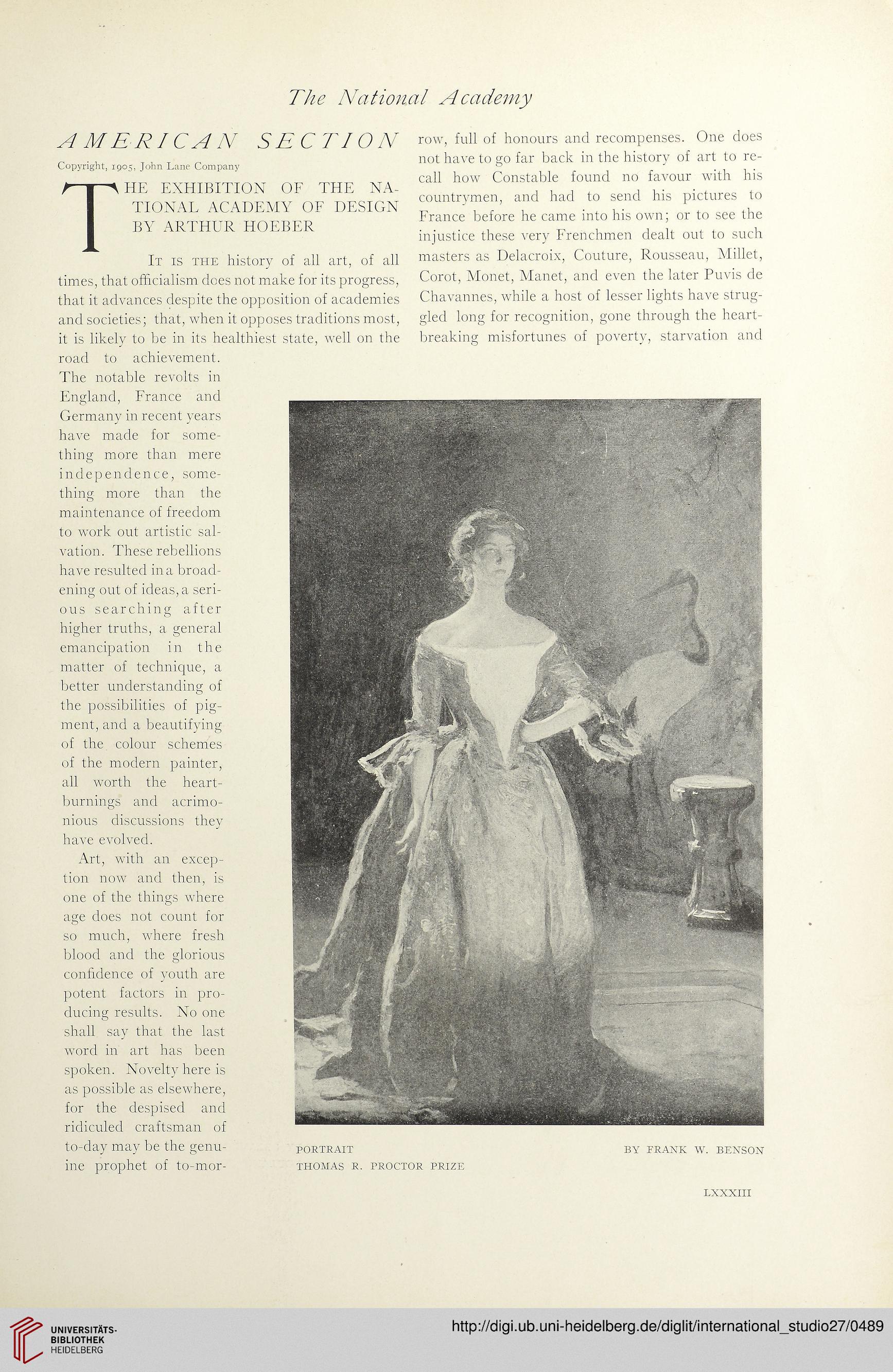The National Academy
AMERICAN SECTION
Copyright, 1905, John Lane Company
HE EXHIBITION OF THE NA-
TIONAL ACADEMY OF DESIGN
BY ARTHUR HOEBER
It is the history of all art, of all
times, that officialism cloes not make for its progress,
that it advances despite the Opposition of academies
and societies; that, when it opposes traditions most,
it is likely to be in its healthiest state, well on the
road to achievement.
The notable revolts in
England, France and
Germany in recent years
have made for some-
thing more than mere
independence, some-
thing more than the
maintenance of freedom
to work out artistic Sal-
vation. These rebellions
have resulted in a broacl-
ening out of ideas,a seri-
ous searching after
higher truths, a general
emancipation in the
matter of technique, a
better understanding of
the possibilities of pig-
ment, and a beautifying
of the colour schemes
of the modern painter,
all worth the heart-
burnings and acrimo-
nious discussions they
have evolved.
Art, with an excep-
tion now and then, is
one of the things where
age does not count for
so much, where fresh
bloocl and the glorious
confidence of youth are
potent factors in pro-
ducing results. No one
shall say that the last
word in art has been
spoken. Noveltv here is
as possible as elsewhere,
for the despised and
ridiculed craftsman of
to-day may be the genu-
ine prophet of to-mor-
row, full of honours and recompenses. One does
not have to go far back in the history of art to re-
call how Constable found no favour with his
countrymen, and had to send his pictures to
France before he came into his own; or to see the
injustice these very Frenchmen dealt out to such
masters as Delacroix, Couture, Rousseau, Millet,
Corot, Monet, Manet, and even the later Puvis de
Chavannes, while a host of lesser lights have strug-
gled long for recognition, gone through the heart-
breaking misfortunes of poverty, starvation and
PORTRAIT BY TRANK W. BENSON
THOMAS R. PROCTOR PRIZE
LXXXIII
AMERICAN SECTION
Copyright, 1905, John Lane Company
HE EXHIBITION OF THE NA-
TIONAL ACADEMY OF DESIGN
BY ARTHUR HOEBER
It is the history of all art, of all
times, that officialism cloes not make for its progress,
that it advances despite the Opposition of academies
and societies; that, when it opposes traditions most,
it is likely to be in its healthiest state, well on the
road to achievement.
The notable revolts in
England, France and
Germany in recent years
have made for some-
thing more than mere
independence, some-
thing more than the
maintenance of freedom
to work out artistic Sal-
vation. These rebellions
have resulted in a broacl-
ening out of ideas,a seri-
ous searching after
higher truths, a general
emancipation in the
matter of technique, a
better understanding of
the possibilities of pig-
ment, and a beautifying
of the colour schemes
of the modern painter,
all worth the heart-
burnings and acrimo-
nious discussions they
have evolved.
Art, with an excep-
tion now and then, is
one of the things where
age does not count for
so much, where fresh
bloocl and the glorious
confidence of youth are
potent factors in pro-
ducing results. No one
shall say that the last
word in art has been
spoken. Noveltv here is
as possible as elsewhere,
for the despised and
ridiculed craftsman of
to-day may be the genu-
ine prophet of to-mor-
row, full of honours and recompenses. One does
not have to go far back in the history of art to re-
call how Constable found no favour with his
countrymen, and had to send his pictures to
France before he came into his own; or to see the
injustice these very Frenchmen dealt out to such
masters as Delacroix, Couture, Rousseau, Millet,
Corot, Monet, Manet, and even the later Puvis de
Chavannes, while a host of lesser lights have strug-
gled long for recognition, gone through the heart-
breaking misfortunes of poverty, starvation and
PORTRAIT BY TRANK W. BENSON
THOMAS R. PROCTOR PRIZE
LXXXIII





